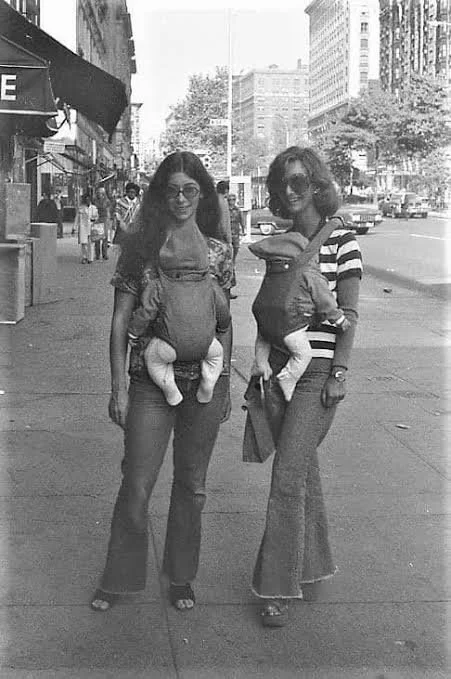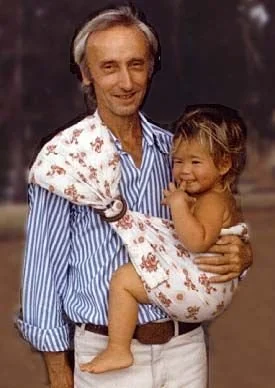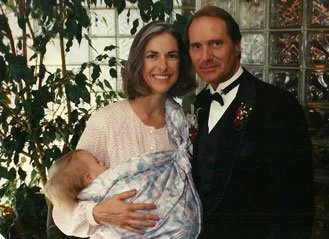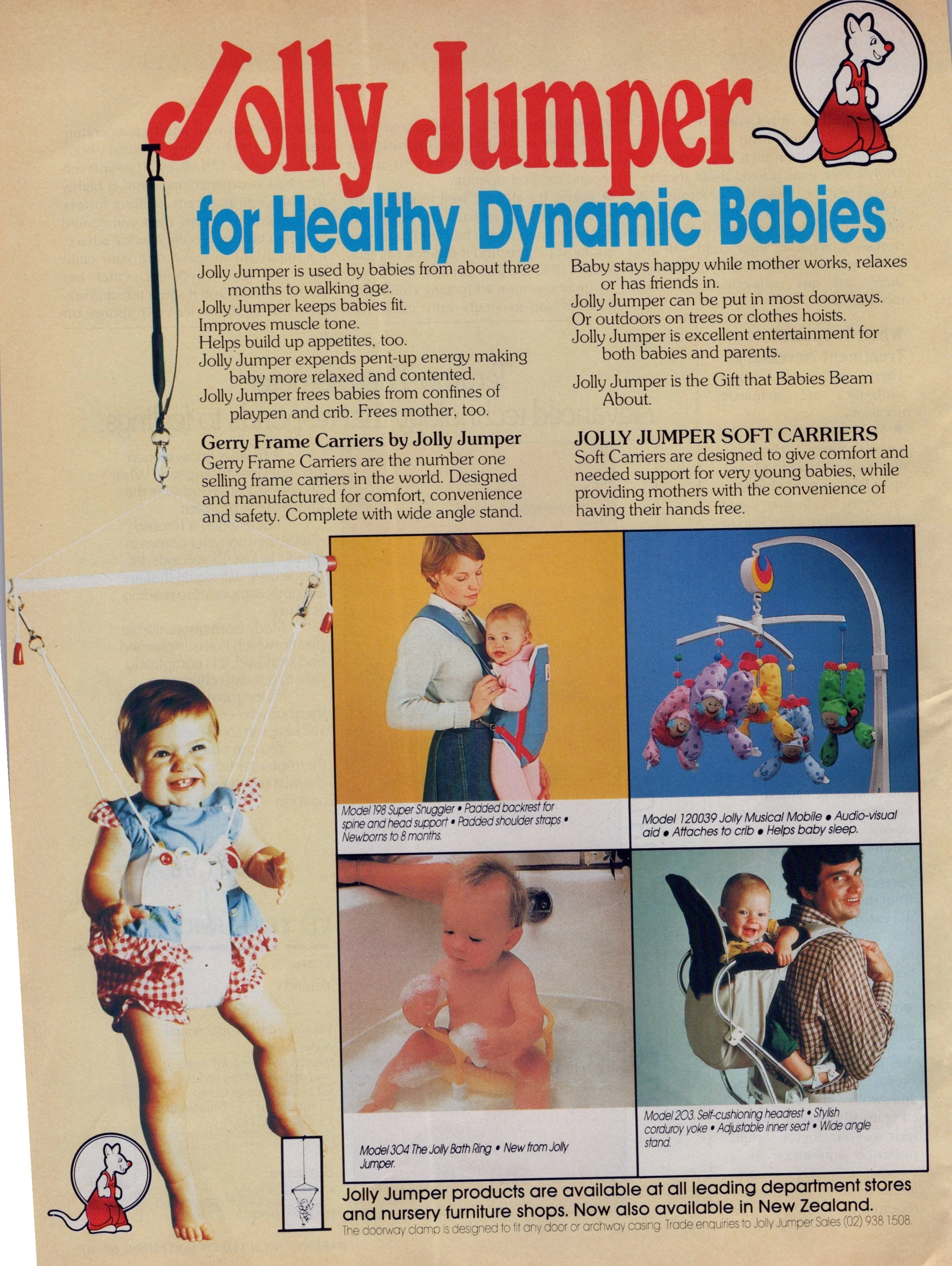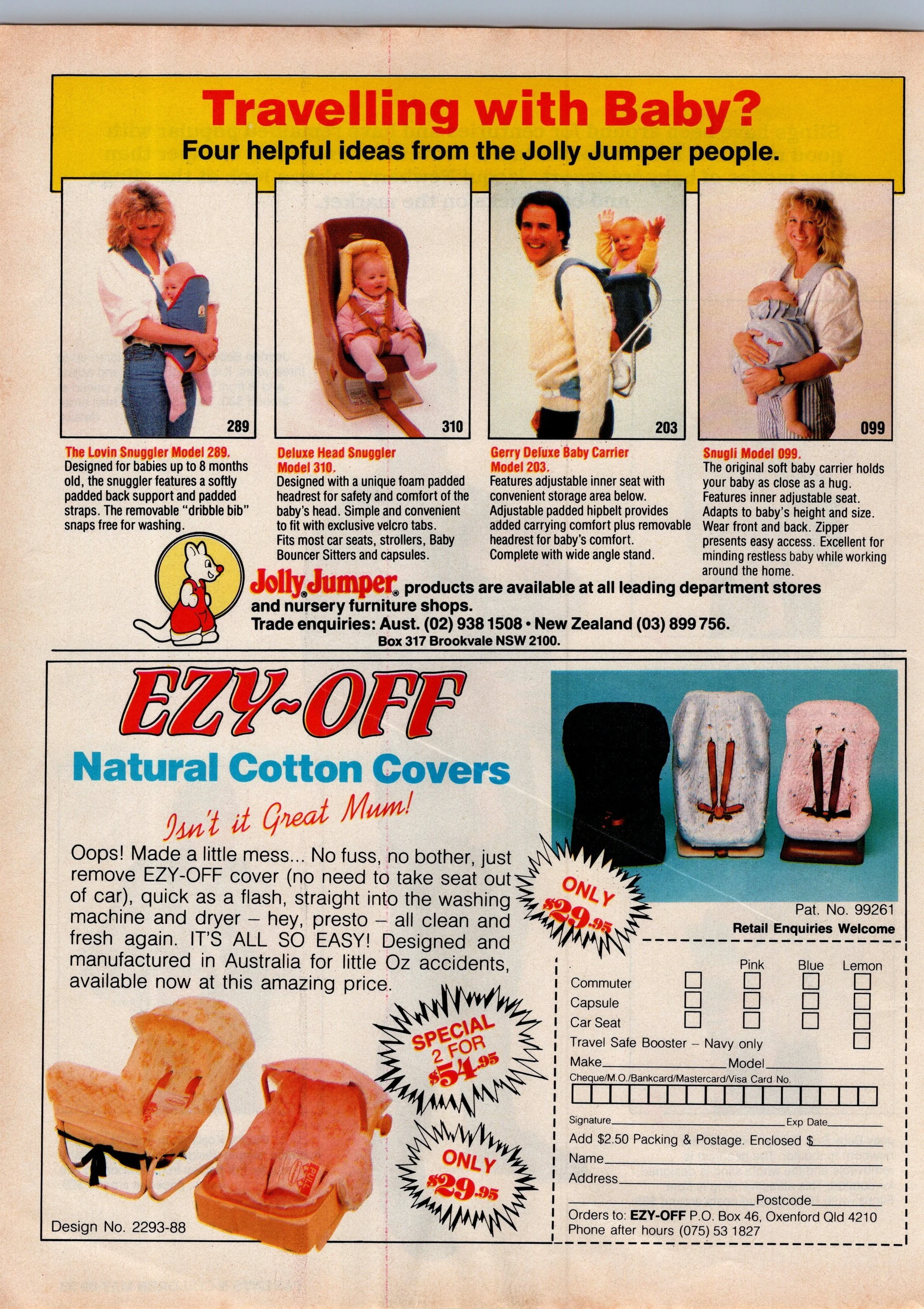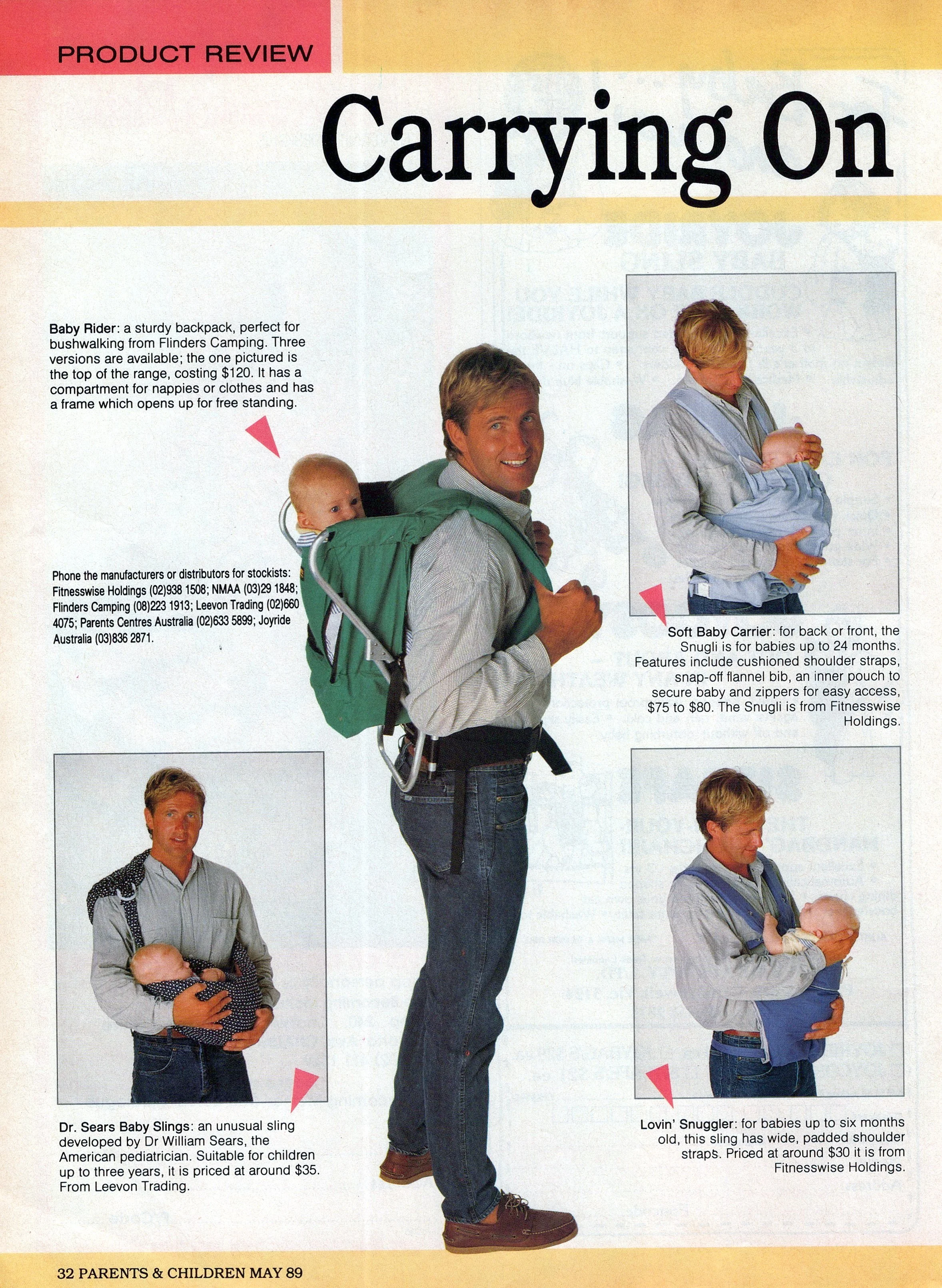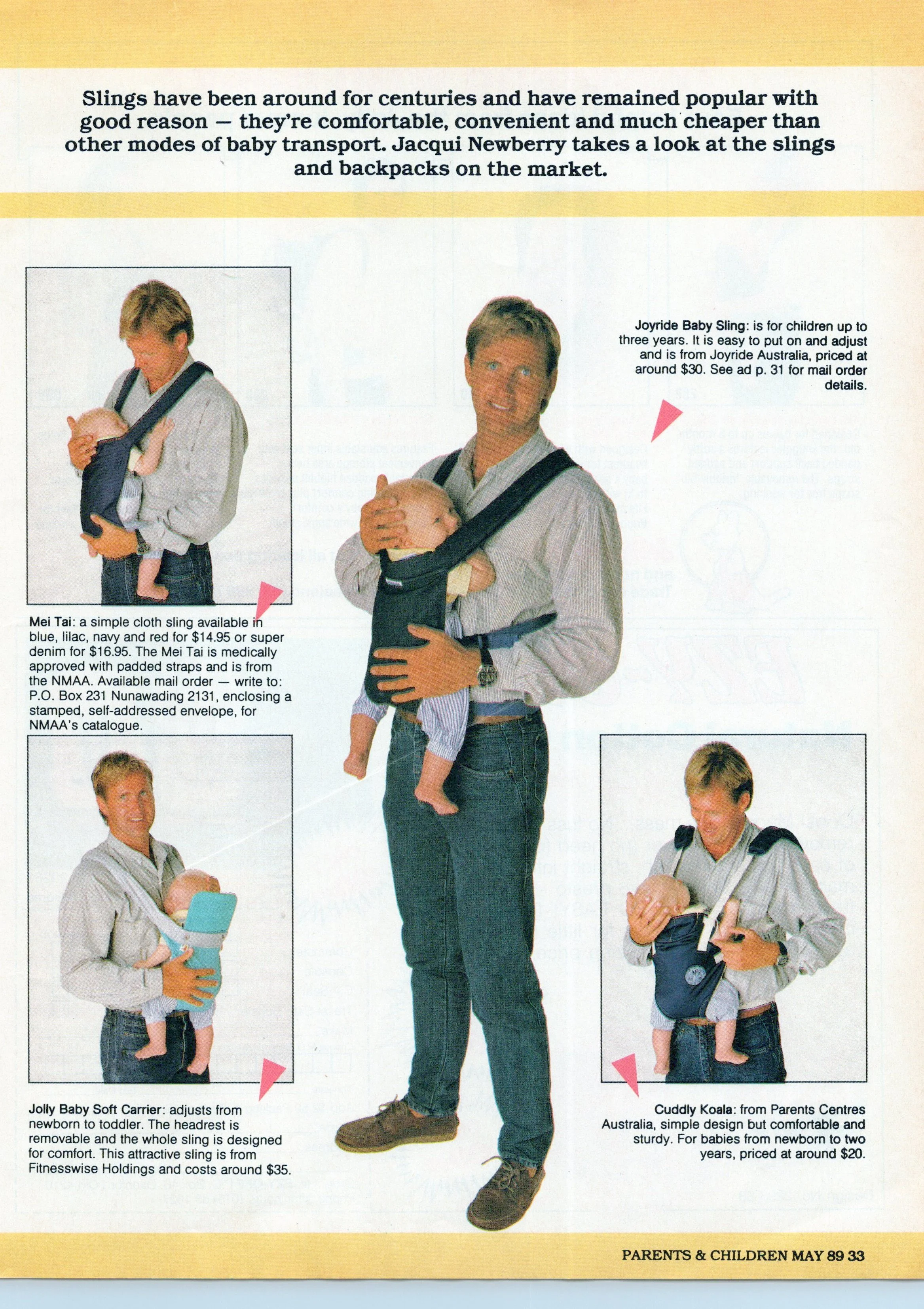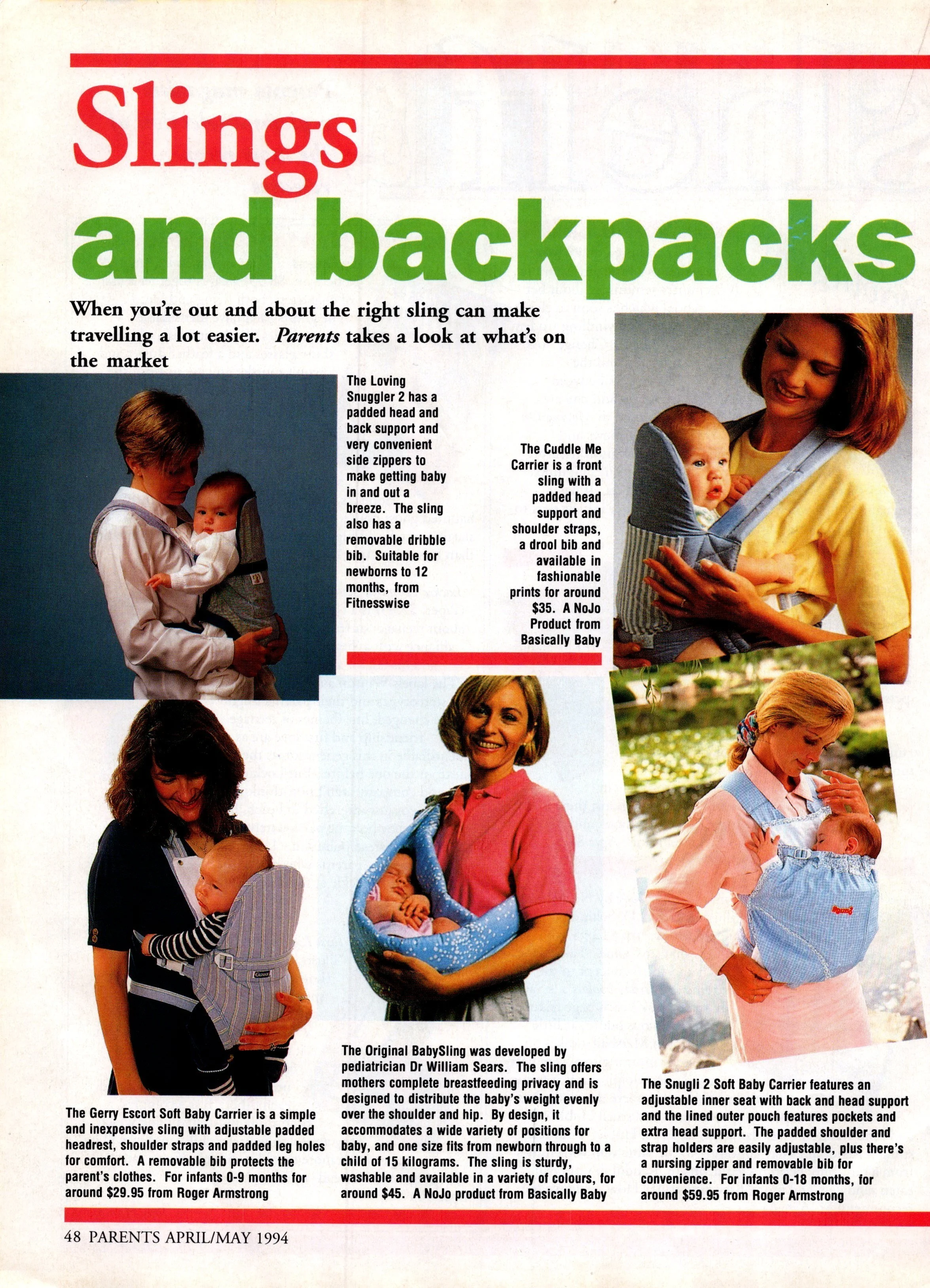The Birth of Babywearing: Reclaiming Connection
Honoring Martha Sears, who gave us the word and helped shape the movement. 1945 - 2025
““I really enjoy wearing Mathew. The sling is like a piece of clothing. I put it on in the morning and take it off in the evening””
1970s–1980s: The birth of babywearing
Social movements in the 1970s — including feminism, the natural childbirth movement, and a renewed interest in Indigenous and ancestral practices — sparked a return to softer, more responsive parenting. Jean Liedloff’s The Continuum Concept (1975) inspired many Western parents to rethink infant separation.
Two mothers stand confidently on a sunlit New York City footpath in the 1970s, babies tucked securely against their chests in early front-pack baby carriers. Bell-bottom jeans, platform sandals, and oversized sunglasses capture the spirit of the era, while the carriers — minimalist in design, with buckled shoulder straps and narrow bases — reflect a pivotal moment in babywearing history. These carriers mark the dawn of a commercial revival in Western parenting, reintroducing the idea of keeping babies close while navigating busy city life. With their hands free and babies content, these women embody a quiet but radical return to connected care.
📷 Photograph by Morris Huberland
Pioneers like Erica Hoffmann (Didymos), Rayner and Sacchi Garner (ring sling), and William and Martha Sears (who coined babywearing) helped revive carrying in Western contexts, connecting it to attachment and breastfeeding advocacy.
Erica Hoffmann, founder of Didymos in Germany, was instrumental in reviving and modernising woven wrap babywearing in Western Europe. In 1972, after the birth of her twins, Erica sought a way to keep both babies close while continuing daily life. Inspired by traditional carrying methods she had observed and researched, she began experimenting with long woven cloths that could support her babies securely and comfortably. Learn more about Erica Hoffman here
The 1980s was a boom time for baby carrying. Mainstream parenting books and magazines were now promoting the practice and more commercial carriers hit the market. Baby Boomers wore their babies in an array of styles and designs.
Raynar Garner
Raynar Garner, together with his wife Sacchi, played a groundbreaking role in the modern revival of the ring sling. Inspired by traditional cloth carriers but seeking a more adjustable and user-friendly option, they developed a design that incorporated rings to create an easily adjustable sling. This allowed caregivers to quickly tighten or loosen the fabric for comfort and security, making it possible to carry babies high and close while distributing weight effectively. The ring sling's simplicity and versatility resonated strongly with parents seeking to keep their babies close while maintaining freedom of movement. Raynar and Sacchi’s innovation helped bring babywearing into mainstream awareness in Western countries, encouraging more families to reconnect with the instinct to hold and respond to their babies throughout the day. Their design remains a beloved choice worldwide, embodying the balance of practicality, responsiveness, and intimate connection.
Learn more about Raynar Garner’s story here
Martha and William Sears.
Dr. William Sears and his wife, Martha Sears, played a pivotal role in popularising babywearing in the United States through their advocacy of “attachment parenting” in the 1980s and 90s. As a pediatrician and a registered nurse and lactation consultant, respectively, the Searses combined medical expertise with practical, compassionate parenting guidance. They strongly believed that keeping babies close — both physically and emotionally — fostered secure attachment, emotional resilience, and healthy development.
While they didn’t invent the ring sling, the Searses enthusiastically embraced and promoted its use as part of their parenting philosophy. They advocated for adjustable slings because they allowed parents to carry their babies comfortably, keep them at a kissable height, and respond intuitively to their needs. Through their books, talks, and media appearances, William and Martha Sears introduced countless Western families to the concept of babywearing as an everyday, loving practice rather than a niche or alternative choice.
Their work helped normalize babywearing among mainstream audiences, encouraging a return to practices that align with human instincts and biological needs. Today, their influence can still be felt in the ongoing emphasis on closeness, responsiveness, and connection in modern parenting conversations.
Together, these pioneers — and many unnamed parents around the world — helped keep babywearing alive through a century marked by prams, cots, and a push toward physical separation. They reminded us that carrying our babies is not simply a parenting choice but a deeply human instinct, bridging modern life with our shared ancestral wisdom.
Their contributions laid the foundation for today’s thriving babywearing communities and the growing diversity of carrier designs. By weaving together traditional practices and new ideas, they ensured that the art of carrying remains a living, evolving expression of love and connection.
RIP Martha Sears
As I am writing this, the Sears family have shared that Martha Sears has passed away on June 28th 2025. Martha coined the term babywearing and I would like to dedicate this series to her.
Learn more about The Sears story here
My first baby carrier, purchased in 1984 for my first child, was a Jolly Jumper design as featured in these ads from Parents and Childrens magazine. By the time I was pregnant with my second child, I had fallen in love with the NMAA Meh Tai and that was it.
Yvette with 6wo Kaitlyn in December 1987
Kapoochi: An Australian innovation in baby carriers
The Kapoochi brand is a fascinating chapter in the story of babywearing in Australia. Emerging in the early 1990s, Kapoochi offered a distinctly Australian take on soft baby carriers and pouches, blending local design ingenuity with the growing demand for hands-free baby care options.
Kapoochi’s best-known products were the Kapoochi Baby Carry Pouch and the Kapoochi Cocoon. These carriers were designed to offer flexibility — babies could be worn either front or rear facing, depending on their age and developmental stage. The unique feature of the Cocoon was its ability to slip over the entire pouch as a weather cover, providing protection from wind and rain without the need for additional bulky covers. This was particularly appealing to Australian families who loved to spend time outdoors in varying climates.
Unlike many carriers of the time, the Kapoochi pouch was extremely lightweight and could fold down into a compact carry bag, making it convenient for travel and storage. It was also positioned as a more affordable and accessible alternative to imported structured carriers or traditional framed backpacks, which were often heavy and cumbersome.
Kapoochi’s design choices reflected the priorities of many Australian parents in the 1990s: practicality, simplicity, and adaptability. The brand marketed itself as a modern solution for busy, active families who wanted to keep their babies close while enjoying an outdoor lifestyle.
Distributed by Halstar and featured widely in Australian parenting magazines and major baby stores, Kapoochi quickly gained recognition and became a popular choice. It stood alongside other carriers like Snugli and Gerry in providing an option that blended convenience with the emerging awareness of the benefits of babywearing.
While Kapoochi no longer has the same presence today and has largely faded from the mainstream market, it played an important role in normalising babywearing in Australia during the 1990s. The brand’s innovative approach helped pave the way for the explosion of carrier options that would arrive in the 2000s, as parents increasingly looked for products that supported bonding, mobility, and comfort.
These 1990s carriers show an important transition phase: from purely structured, stiff carriers toward soft slings and adjustable options inspired by traditional designs.
Dr. Sears' influence is clearly visible, bringing the "babywearing" concept (as a term and philosophy) into Australian homes.
Many models borrowed heavily from Asian-style carriers but were heavily adapted to suit Western preferences for padding, buckles, and prints.
The presence of Nursing Mothers' Association in distributing meh tais suggests that breastfeeding advocacy and babywearing education were already starting to intersect.
By this point, big brands and small local businesses were starting to coexist, though home sewing and DIY carriers were still popular in some communities.
BabyBjörn: Popularizing front packs — and sparking a wider conversation
The Swedish brand BabyBjörn played a major role in bringing baby carrying into the mainstream consciousness in Western countries. Founded in 1961, BabyBjörn initially produced baby bouncers and other infant products, but it was their soft front baby carrier — launched in the 1970s — that truly defined the brand.
By the 1980s and 90s, the BabyBjörn carrier had become almost a cultural icon. It was praised for allowing parents to keep their babies close while having their hands free, a novelty at the time for many Western families. The brand’s marketing emphasised sleek design and Scandinavian simplicity, and celebrity use helped cement its popularity.
However, BabyBjörn’s original design was a narrow-based front pack, which placed most of the baby’s weight on the crotch and allowed the legs to dangle straight down. As understanding of healthy hip development and optimal positioning grew — particularly through the influence of physiotherapists, pediatric orthopedists, and babywearing educators — concerns emerged around this “crotch-dangling” style.
Advocates of wider-based, ergonomic carriers argued that a better option was to support babies in a “M” position (knees higher than bottom, thighs supported), which helps protect developing hips and encourages healthy spinal development. This positioning is especially important in the first six months when hips are most vulnerable.
While BabyBjörn has since responded to some of these concerns by introducing models with wider seats and more ergonomic options, their original narrow-based design remains closely associated with their brand image. Many babywearing educators today still caution against narrow-based carriers for long-term use, particularly for young infants.
As babywearing educator and author Dr. Rosie Knowles explains in her book Why Babywearing Matters (2016):
"A narrow-based carrier may be popular and easy to find, but it does not provide the optimal support a baby’s hips and spine need in the early months. We recommend carriers that hold babies in a seated squat position, which promotes comfort and long-term health."
BabyBjörn undeniably helped normalize the idea of carrying babies on the front and made babywearing more visible in mainstream culture. However, it also inadvertently sparked a broader discussion on what truly supports a baby’s physical and emotional development — a conversation that shaped the evolution of modern carrier design worldwide.
The risks of "front pack" carriers and the cradle position
As babywearing regained popularity in the late 20th and early 21st centuries, many commercial designs emerged that prioritized convenience and market trends over physiological positioning and safety. Among these were structured “front pack” carriers that suspend the baby vertically, facing outward, with legs dangling straight down. Rather than being held snugly against the caregiver’s body, the baby effectively hangs from the carrier, which can place undue stress on developing hips and spine, potentially increasing the risk of hip dysplasia.
At the same time, the cradle position — where a baby lies horizontally across the caregiver’s chest — also became popular in certain soft carriers and pouch slings. While it might seem cozy, this position often leads to the baby’s chin tucking toward the chest, which can dangerously restrict the airway and make it harder for caregivers to monitor breathing.
One particularly hazardous variation was the so-called “bag-style” sling carrier. These deep, hammock-like pouches often had elastic edges and enclosed the baby completely, creating a risk of suffocation. Following multiple infant deaths, these carriers were banned in some countries and are now widely recognized as unsafe by babywearing experts.
These concerns reinforced the importance of safe positioning guidelines, such as the T.I.C.K.S. rules, which emphasize keeping babies upright, close enough to kiss, and with clear airways at all times. Today, babywearing educators encourage using carriers that support babies in an ergonomic seated “M” position, held firmly against the caregiver’s body — honoring both safety and the instinctual need for closeness.
Late 20th century: Globalisation and rising consumerism
As "late capitalism" and globalisation accelerated in the 1980s and 1990s, a new wave of parenting products flooded markets worldwide. While babywearing saw a renaissance, the emergence of mass-marketed carriers sometimes prioritised fashion and convenience over physiological safety. At the same time, communities of parents and educators began advocating for ergonomic designs and traditional methods.
By the end of the 20th century, babywearing in Australia — and much of the Western world — had undergone a quiet but powerful reawakening. From structured packs and simple pouches to ring slings and the first woven wraps trickling in from Europe, parents were rediscovering what many cultures had always known: babies thrive when held close.
The 1990s saw both mainstream commercial carriers, and small-scale innovations, such as the Kapoochi and the handmade ring slings, coexisting and slowly shifting cultural norms. Community groups, breastfeeding advocates, and a few brave local businesses began planting seeds that would soon blossom into a much broader movement.

